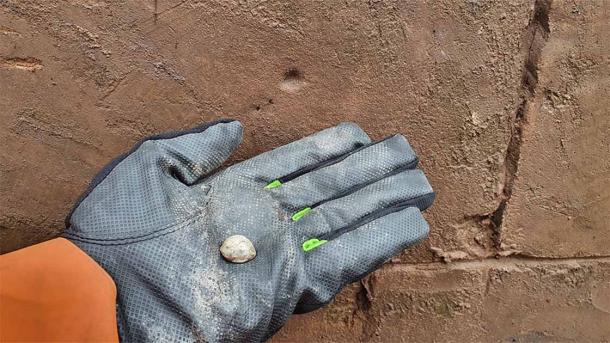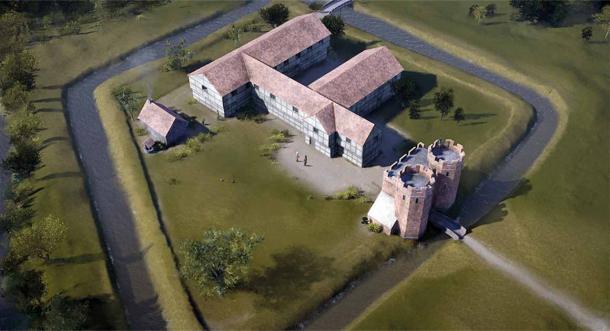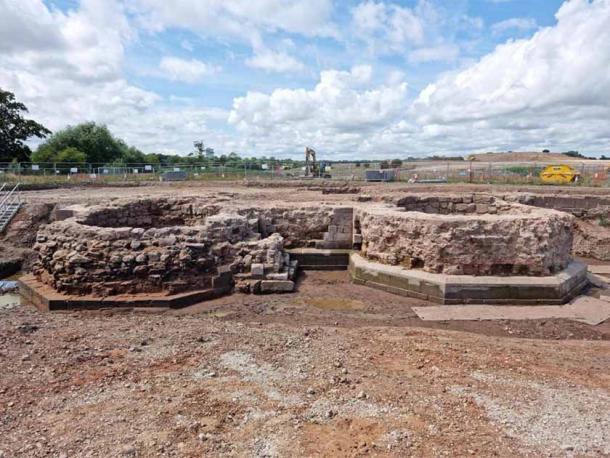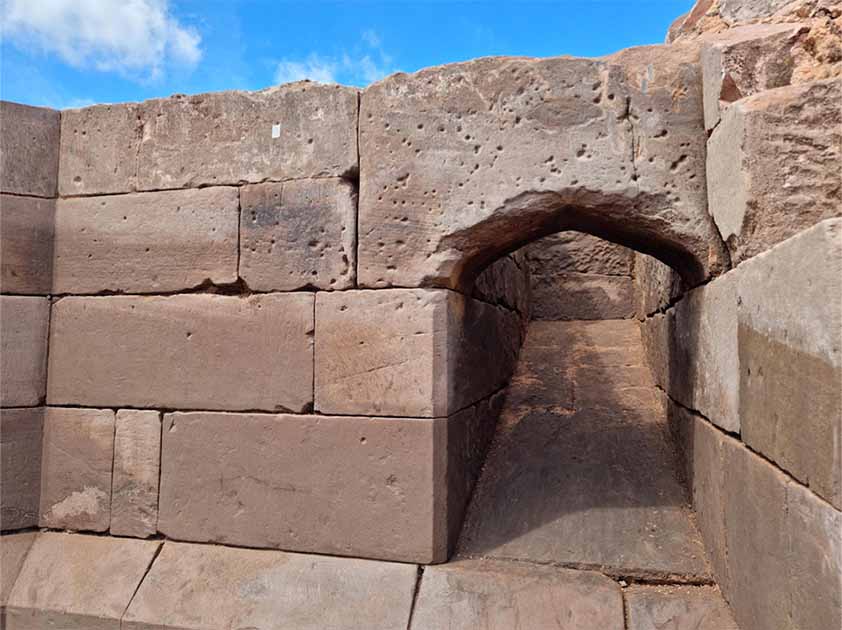Medieval Gatehouse Reveals Hundreds of Musket Ball Marks from English Civil War
While digging at a centuries-old estate in Warwickshire known as Coleshill Manor, archaeologists from the United Kingdom’s HS2 high-speed rail project unearthed evidence of an armed conflict that marked the outbreak of hostilities in the 17th century English Civil War. Around 200 musket ball impact marks, along with more than 40 musket balls were found on the heavily fortified medieval gatehouse.

Musket ball impact on Coleshill Manor gatehouse and musket ball shot found below. Source: HS2
HS2 Railway Unearths Unexpected Ruins at Coleshill Manor
Last year, a team of archaeologists deployed by the HS2 contractor Wessex Archaeology were digging at the historic Coleshill Manor site, which was once occupied by aristocrats and government officials. The HS2 media center has announced that during these most recent excavations, the excavators unearthed the large stone bases of two towers that were once part of a fortified gatehouse that was likely constructed more than 700 years ago.
- Military Historian Discovers Hannibal’s Long-Lost Battlefield
- Grisly Discovery of Dozens of Beheaded Skeletons in Britain
This discovery was notable, but the ruins proved to be even more of an important find that originally realized. After a close examination of the sandstone walls of the tower bases, the researchers found approximately 200 battle scars, or marks left by musket and pistol fire, distributed across a heavily pockmarked surface. It was clear the fortified gatehouse had come under heavy fire at some point.

CGI reconstruction of Coleshill Manor, which was a Royalist stronghold during the English Civil War. (HS2)
Under Fire: Archaeologists Speculate on Cause of Battle Scars
Since Coleshill Manor would have been a Royalist stronghold, the archaeologists speculate that the marks on the walls may have been left as souvenirs by Parliamentarian troops marching through on their way to confront Royalist armies at what would come to be known as the Battle of Curdworth Bridge. This would make the attack on Coleshill Manor — and any retaliation it provoked — one of the very first, if not the first, armed conflict of the English Civil War.
This nine-year-long clash, between 1642 and 1651, pitted the Royalist forces of Charles I against the Parliamentarians (also known as “Roundheads”), in a struggle for political and religious control of the medieval English realm.
Adding further proof that such an event took place, the HS2 archaeologists unearthed 40 musket balls buried in the soil around the gatehouse, in an area that may have been at the bottom of a moat in the mid-17th century.
The archaeologists were quite surprised to find the remains of the monumental stone building, which would have featured two huge octagon-shaped towers. It would have been necessary for attackers to strike at the gatehouse if they planned to attack Royalists living at Coleshill Manor, but it is unlikely that they were able to get past the gatehouse to inflict any damage to the manor building itself.
Coleshill Manor and the English Civil War
The English Civil War began in August 1642, with the Battle of Curdworth Bridge representing the officially recognized outbreak of full-scale hostilities. At this point Coleshill Manor was occupied by the descendants of Simon Digby, an aristocrat and political official who’d taken possession of the massive estate when its previous owner, Simon de Montford, was arrested and charged with treason in the late 15th century.
Coleshill Manor was constructed next to a bridge that passed over the River Cole. For this reason, it was located at a strategically important spot that the Royalists would have wanted to hold and the Parliamentarians would have wanted to seize. The Parliamentarian forces were on the move during that chaotic August of 1642, and as they passed by the Manor on their way to Curdworth Bridge it would have been logical for them to strike quickly and seize the Manor as a base of operations, to gain an early advantage in the fighting.
Unfortunately, no historical records are available to confirm that a skirmish took place at Coleshill. Records only reference the biggest and most important battles, such as the one that took place at nearby Curdworth. But the marks on the tower foundation walls are telltale evidence of heavy gunfire, which has no obvious link to any event outside the Civil War.
Hitting the Books: 17th-Century Records Provide Much-Needed Clues
The discovery of the gatehouse foundation was surprising, but not a complete shock. There was one brief mention of it in 17th century records, so archaeologists knew it might be on the manor grounds somewhere.
The gatehouse would have been an important defensive feature of the Manor, and its presence indicated the high status enjoyed by its occupants. In all probability, the gatehouse would have opened to a drawbridge built over a moat. The structure included a large, solid stone building that was approximately 33 feet by 33 feet (10 meters by 10 meters) in size, plus the two fortified eight-sided towers made from precisely carved stone blocks.
- Magnificent Elizabethan-era Garden Unearthed At Coleshill Manor
- Amputation Pit with Sawn-Off Limbs Found at Battle of Waterloo Field Hospital Site
It is believed the gatehouse was constructed in the 13th or 14th centuries, and that it remained in use until the 1650s (the English Civil War ended in 1651). Sometime in the late 17th century it was torn down to make room for a more modern estate, which featured a courtyard and a collection of decorative gardens. The centerpiece of the manor grounds, an Elizabethan ornamental garden that dated back to the 16th century, was detected during an aerial survey of estate grounds that preceded the excavations.

Remains of the large stone bases of two towers that were once part of a fortified gatehouse likely constructed more than 700 years ago. (HS2)
Another HS2 Marvel Shakes Up British Archaeology
In the wake of this unexpected find, the Wessex Archaeology team expressed their delight at discovering actual physical evidence of a war that ended more than 370 years ago, but still stands as one of the most significant military and political events in British history.
They noted the fascinating contrast between the battle-scarred gatehouse and the elaborate Elizabethan era ornamental garden. The garden was constructed as a peaceful oasis, but it seems the residents of Coleshill Manor experienced the complete opposite of peace and tranquility during one frightening episode that marked the arrival of the tumultuous Civil War period.
Yet again, excavations associated with the ongoing HS2 project have produced some amazing results that shed new light on the United Kingdom’s colorful and eventful past. The latest discoveries from Coleshill Manor were featured on a recent episode of the historical series Digging for Britain, and this episode is now available for on-demand streaming on the BBC2 website for people living in the UK.
Top image: Musket ball marks found on the outside wall of the Coleshill Manor gatehouse are thought to be battle scars from the English Civil War. (HS2)




















Comments
No way that complex gets covered up in all that dirt in only 300 years or so. NO WAY! Look how deep it is (two photos of the dig below):
https://img-s-msn-com.akamaized.net/tenant/amp/entityid/AA16Av9s.img?w=1...
https://cdn.prgloo.com/media/fb2b28410f084248b2b3a59d09c92966.png?
Glaciers must have buried it, ...obviously pre-Ice (stone age) construction. If they were quarrying and moving stones that size in the 17th Century, it would be well-documented in the texts of those times. But there’s nothing on that.
And so the question becomes, did the ancients have lead ball firearms that would do that? Or did something else make those marks way, way back then? Probably something else. The flattened musket ball is dubious. Was it really found there? If so, you would expect more than just one. So easy to find with a metal detector. And the other thing is, why would somebody waste ammo like that, and risk a ricochet back at them? And you’d have to demonstrate that a musket ball would make such nice round indentation in the stone, and not one more jagged, with pieces cracked off, like a bullet normally does to a block wall.
Nobody gets paid to tell the truth.